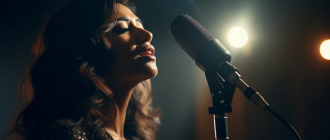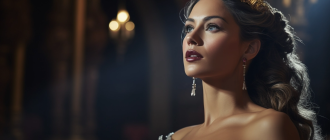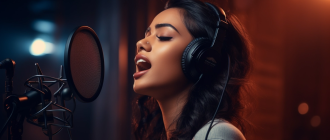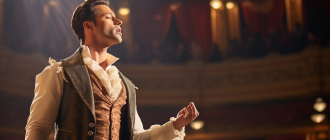Demystifying opera voices and exploring the different voice types of opera singers 🦸♂️🦹♂️ Learn about aria and the basics of each opera voice type
Opera Voices: A Guide to the Different Voice Types
Opera is renowned for its grand spectacle and lavish productions. But at its core, opera is all about the power of the unamplified human voice. Opera singers use their voices to convey intense emotion and dramatic narrative through song. Becoming an opera singer requires years of vocal training to develop the technique and range needed to sing over a full orchestra without a microphone.
There are seven main voice types in opera: soprano, mezzo-soprano, contralto, countertenor, tenor, baritone, and bass. The opera voice types differ in vocal range, timbre, vocal weight, and the roles they sing onstage.
Soprano
The soprano is the highest female voice type with a vocal range from approximately middle C to the C two octaves above middle C (C4-C6). The soprano voice is typically light, agile, and bright in timbre with a brilliant upper register.
Sopranos usually take on leading heroine roles in opera. Famous soprano roles include Lucia in Donizetti’s Lucia di Lammermoor, Violetta in Verdi’s La Traviata, and the Queen of the Night in Mozart’s The Magic Flute. Well-known sopranos include Maria Callas, Joan Sutherland, and Renée Fleming.
There are several subcategories of soprano:
- Coloratura soprano – Very high, agile voice suited for florid, ornamented music
- Soubrette – Light, sweet voice best suited for comic roles
- Lyric soprano – Warm, rounded voice that can sustain long phrases
- Spinto soprano – Powerful, cutting voice with a brilliant top register
- Dramatic soprano – Full, rich voice with immense power and stamina

Mezzo-Soprano
The mezzo-soprano is the middle female voice with a range from approximately the G below middle C to the A two octaves above (G3-A5). The mezzo voice has a darker, warmer color than the soprano. Mezzos are known for a strong middle register and an ability to sing smoothly between chest and head registers.
Mezzo roles often portray seductresses, mothers, nurses, and occasionally teenage boys (“trouser roles”). Well-known mezzo roles include Carmen in Bizet’s Carmen, Dalila in Saint-Saëns’ Samson et Dalila, and Hansel in Humperdinck’s Hansel and Gretel. Famous mezzos include Cecilia Bartoli, Joyce DiDonato, and Elina Garanca.
There are three main subcategories of mezzo:
- Coloratura mezzo – lower voice with an extended upper range and florid agility
- Lyric mezzo – middleweight voice with smooth timbre and excellent legato
- Dramatic mezzo – powerful, flashy voice that can project over a full orchestra
Contralto
The contralto is the lowest female voice type with a range from approximately the F below middle C to a high F (F3-F5). True contraltos are quite rare. The contralto voice has a deep, dark, rich timbre.
In opera, contraltos often portray older female characters including fortune tellers, grandmothers, and witches. Famous contralto roles include Ulrica in Verdi’s Un Ballo in Maschera and Erda in Wagner’s Das Rheingold. Renowned contraltos include Maureen Forrester, Kathleen Ferrier, and Ewa Podles.
Countertenor
The countertenor is the highest male voice type with an approximate range from G3 to C6. Countertenors sing in the mezzo-soprano or contralto range using specialized vocal technique called head voice. Countertenors were popular in the Baroque era, declined in the Classical and Romantic periods, and have seen a resurgence in 20th-century and contemporary opera.
Many countertenor roles originate from parts written for castrati. Famous countertenor roles include Oberon in Britten’s A Midsummer Night’s Dream, Nerone in Monteverdi’s L’Incoronazione di Poppea, and the title role in Philip Glass’ Akhnaten. Well-known countertenors include David Daniels, Philippe Jaroussky, and Bejun Mehta.
Tenor
The tenor is the highest natural adult male voice with a range from approximately the C below middle C to the C above (C3-C5). The tenor voice has a light, bright timbre and a brilliant upper register.
Tenors usually take on leading male roles including the hero, the romantic lead, and the boyish youth. Iconic tenor roles include Don Jose in Bizet’s Carmen, Rodolfo in Puccini’s La Bohème, and Tamino in Mozart’s The Magic Flute. Famous tenors include Luciano Pavarotti, Placido Domingo, and Jonas Kaufmann.
There are several subcategories of tenor:
- Tenore leggero – light, agile voice that excels in comic roles
- Lyric tenor – smooth, flexible voice capable of both powerful and tender singing
- Spinto tenor – robust voice with squillo and ability to “push” volume in climaxes
- Dramatic tenor – powerful, cutting voice with stamina for intense roles
- Heldentenor – bright, metallic voice for intense Wagnerian hero roles

Baritone
The baritone is the middle male voice with a range from about the second G below middle C up to the G above (G2-G4). Baritones have a strong middle register and smooth vocal timbre.
Baritones often portray villains, fathers, authoritative figures, and romantic leads. Famous baritone roles include Figaro in Rossini’s The Barber of Seville, Count Almaviva in Mozart’s The Marriage of Figaro, and the title roles in Verdi’s Rigoletto and Puccini’s Gianni Schicchi. Renowned baritones include Sherrill Milnes, Thomas Hampson, and Dmitri Hvorostovsky.
There are two main subcategories of baritone:
- Lyric baritone – lighter, nimble voice for comic roles and young characters
- Dramatic baritone – powerful, bold voice for mature characters and villains
Bass
The bass is the lowest male voice with a range from about the E above middle C down to the E two octaves below (E2-E4). The bass voice has a rich, booming, resonant timbre. Basses often portray aged, wise, or villainous characters.
Famous bass roles include Don Basilio in Rossini’s The Barber of Seville, King Philip in Verdi’s Don Carlo, and Sarastro in Mozart’s The Magic Flute. Notable bass singers include Ferruccio Furlanetto, René Pape, and Samuel Ramey.
There are several subtype of bass:
- Bass profundo – extremely low, powerful voice with a subterranean range
- Basso buffo – quick, flexible voice for comic roles
- Basso cantante – lyrical voice with smooth high register
Bass-Baritone
The bass-baritone sits between the baritone and bass with an approximate range from A2 up to F4. The bass-baritone has a long, rich sound with darkness in the low register and resonance in the upper. Bass-baritones often play villainous roles or father figures.
Famous bass-baritone roles include Wotan in Wagner’s Ring Cycle, Scarpia in Puccini’s Tosca, and Peter in Humperdinck’s Hansel and Gretel. Noteworthy bass-baritones include Bryn Terfel, Simon Keenlyside, and Eric Owens.
In summary, opera showcases a wide variety of voice types, each with its own distinct sound and character. It takes an immense amount of training and discipline to develop the technique, stamina, range, and dramatic capabilities required of an opera singer. The different voice types all contribute unique musical colors, textures, and emotional qualities to the opera stage.





